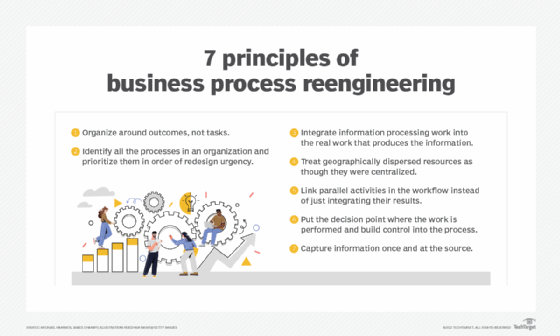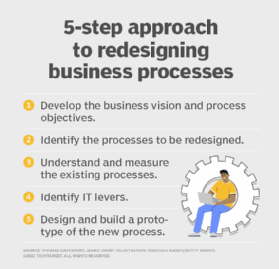business process reengineering (BPR)
What is business process reengineering (BPR)?
Business process reengineering (BPR) is a management practice in which the related tasks required to obtain a specific business outcome are radically redesigned to improve efficiency, effectiveness and performance. By critically examining and redesigning business processes, BPR can also improve other business aspects, such as cost, output, service, speed and quality. BPR helps organizations to fundamentally rethink how they do their work.
BPR can be effectively implemented in organizations of all sizes and across various industries.
BPR aims to analyze workflows within and between business functions to optimize the end-to-end business process. It also seeks to eliminate tasks that don't improve performance or provide the customer with value.
BPR is implemented by analyzing and restructuring current processes in an organization, such as its workflow for example, with the goal of identifying gaps and redesigning the process to streamline and improve it. The use of IT to automate and integrate steps in the process is central to BPR initiatives.

Beginnings
Hammer contended that the usual methods for boosting performance had failed to yield the improvements enterprises needed to operate in the 1990s. Product development cycle times were too slow, order fulfillment errors were too high and inventory levels were out of sync with demand at many companies. As a result, enterprises were ill-equipped to succeed in a time of rapidly changing technologies, rising customer expectations and global competition, he said. Moreover, IT had failed to improve results in performance or customer service because it was being used to simply automate existing, deficient processes. Companies needed to thoroughly reassess whether their existing business processes were providing value and rethink how technology could be used to create entirely new processes.
In contrast to the discipline of business process improvement, which focuses on updating a company's existing business processes, BPR begins with an assessment of the company's mission and the value it provides. Companies embarking on BPR might find they need to rethink their entire business model in addition to radically redesigning their business processes.
How does business process reengineering work?
The principles of business process reengineering were laid out by Hammer and organizational theorist James Champy in "Reengineering the Corporation: A Manifesto for Business Revolution," which became a national bestseller. To achieve significant improvement in quality, time management, speed and profitability, the authors urged businesses to follow these seven principles:
- Organize around outcomes, not tasks.
- Identify all the processes in an organization and prioritize them in order of redesign urgency.
- Integrate information processing work into the real work that produces the information.
- Treat geographically dispersed resources as though they were centralized.
- Link parallel activities in the workflow instead of just integrating their results.
- Put the decision point where the work is performed and build control into the process.
- Capture information once and at the source.
Steps to business process redesign
There are multiple frameworks and steps an organization can follow to implement BPR. For example, even though the process can vary from organization to organization, the following five basic steps summarize the process:
- Map current business processes, gather data from software and stakeholders and understand how the current process is performing.
- Analyze business processes to find any errors and delays that could affect the process.
- Review and confirm any improvement opportunities.
- Design a new process map that solves the problem the organization has identified.
- Implement changes and educate stakeholders on these changes.
The business community's enthusiasm for business process reengineering in the 1990s generated many interpretations of how radical change should be implemented.

Thomas Davenport, a professor at Babson College who collaborated with Hammer before developing his own approach to BPR, used the term business process redesign rather than reengineering and provided business leaders with concrete advice, emphasizing the value of prototypes, simulations and tests.
Davenport's popular book, "The New Industrial Engineering: Information Technology and Business Process Redesign," written with James Short, laid out the following five-step approach to radically change workflow:
- Develop the business vision and process objectives.
- Identify the processes to be redesigned.
- Understand and measure the existing processes.
- Identify IT levers.
- Design and build a prototype of the new process.
A variation on the five-step process is the seven-step INSPIRE framework developed by business process management expert Bhudeb Chakravarti:
- Initiate the new BPR project and prepare the business case.
- Negotiate with senior management for approval to start.
- Select the processes to be reengineered.
- Plan the activities in the project.
- Investigate processes for problems.
- Redesign the selected processes to improve performance.
- Ensure success through monitoring.
BPR team member roles
The radical change advocated by BPR required serious commitment from a company's top executives. BPR implementations during the mid-1990s typically used a team approach that reflected the movement's top-down management philosophy. Such a team might look like the following:
- Team leader. A senior executive who has envisioned and authorized the overall reengineering effort. The team leader is responsible for appointing the process owner.
- Process owner. A senior-level manager in charge of a specific business process. The process owner is responsible for assembling a team to reengineer the process they oversee.
- Reengineering team. A group that's composed of insiders whose work involves the process that is being reengineered and outsiders whose jobs aren't affected by changes in the process. The reengineering team is responsible for analyzing the existing process and overseeing its redesign.
- Steering committee. A group of senior managers who have championed the concept of reengineering within the organization and set specific goals for improving performance. The steering committee, which is led by the team leader, is responsible for arbitrating disputes and helping process owners make decisions about competing priorities.
- Reengineering czar. An individual who is responsible for the day-to-day coordination of all ongoing reengineering activities. The czar's responsibility is to be a facilitator and develop the techniques and tools the organization uses to reengineer workflow.
Examples and use cases of business process reengineering
A sampling of some of the most widely cited use cases during the height of the BPR movement include the following:
- Ford Motor Company. Ford radically changed its accounts payable (AP) process by implementing an online database that tracked the process from purchase order to delivery and then automatically made payments. The move to paperless invoices negated the need for staff to spend time matching paper purchase orders with receiving documents and invoices. By rethinking the purchase process to take advantage of technology, the automotive company reduced its AP department's headcount by 75%.
According to Hammer, success depended on Ford's willingness to break away from established assumptions about how operations should work, a concept he referred to as discontinuous thinking.
- Duke Power Co. In anticipation of power deregulation, Duke Power Co. reengineered its customer operations processes in the 1990s to cut costs and improve customer service. Although the company performed well on both fronts, once it embarked on BPR, many inefficiencies and inconsistencies were identified across Duke's 13 geographic areas. Process owners were appointed, standard measurements were devised for all types of customer service and scorecards were adopted so that employees could track how their work contributed to Duke's business goals of higher earnings and better service.
- IBM Credit Corp. In this case, IBM cut its turnaround time to issue credit from a week or more to hours and even minutes by having a team of executives follow the company's process of credit issuance from application to approval. They discovered that the actual work took 90 minutes. The remainder of the more than seven days, on average, was eaten up by handing off forms from one department specialist to another. IBM replaced its specialists with generalists called deal structurers who, with the help of expert systems, handled the process from start to finish.
Heyday and backlash
BPR became a multibillion-dollar business in the 1990s as marquee companies embraced the concept of radical change enabled by technology. The business press touted BPR success stories at Union Carbide, Ford Motor Co., Taco Bell, GTE Corp. and Bell Atlantic, among others. Consultants and software applications vendors -- including enterprise resource planning providers SAP, Oracle and PeopleSoft -- jumped on the bandwagon.
As quickly as BPR rose in popularity, however, so did the backlash against it. Radical change proved to be expensive and risky. Mapping processes accurately, working across business silos and using IT to drive business goals -- all major components of BPR -- is difficult work. The most frequent critique of BPR as its luster wore off was that it placed too much emphasis on technology and cost reduction and not enough on the ways radical change affects people and company culture. By the end of the 1990s, the term business process reengineering was associated with two unpopular trends of the time: downsizing and outsourcing.
BPR and digital transformation
Digital transformation is the incorporation of computer-based technologies into an organization's products, processes and strategies. Organizations use digital transformation to better engage and serve their workforce and customers.
Similar to BPR, digital transformation initiatives require the examination and reinvention of business processes. The process uses the same BPR concept of radical transformation. Digital transformation, however, is a broader concept that also involves changing customer expectations. Digital transformation focuses on all facets of an organization -- from supply chains and workflows to employee skill sets and org charts, to customer interactions and value propositions to stakeholders.
BPR can also be used as a framework for digital transformation. The adoption of new technologies, such as the internet of things and cloud, along with advances in artificial intelligence, has spurred many companies to radically rethink their workflows and implement the type of technology-driven radical change advocated by BPR. It's also become clear to companies that the concept's focus on radical change can complement process improvement approaches that emphasize incremental change -- such as continuous improvement, or Kaizen, and total quality management.
There are many different strategies an organization can use when changing its business processes. Learn more about digital transformation and its trends.







